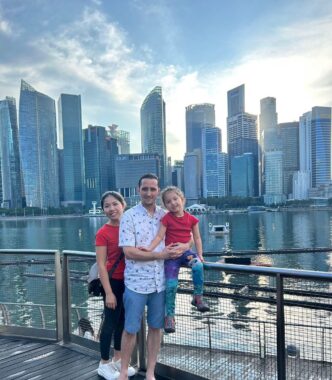Therapy vacations are just what the doctor ordered
Therapy vacations are beneficial for both patient and caregiver, this columnist says
Written by |

Parenting is already a full-time job, but the list of tasks mounts for parents of children with health challenges.
After work during the week and on weekends, my wife and I operate as a team to coordinate our 5-year-old daughter Rylae-Ann’s care and therapy sessions, as she has aromatic l-amino acid decarboxylase (AADC) deficiency. It isn’t optional if we hope to help her make progress.
Anything that might disrupt this schedule was removed from it. As a result, vacations were eliminated from our list of priorities. Recently, however, we found a way to put them back on.
Therapy sessions are a requirement
Once we learned our daughter had AADC deficiency when she was 8 months old, we began early and intensive intervention. This meant a daily therapy schedule that included physical, occupational, and speech therapy. Each therapy session lasted at least an hour. After Rylae-Ann closed her development milestone gap, we were able to reduce the duration of the sessions, yet we continued with daily therapy.
Paramedical therapies are not an option; they are a must. Paramedical treatment, also known as allied health, involves health professionals outside of doctors, dentists, and nurses. There is a long list of options, but our daughter participates in the following:
- Physiotherapy
- Occupational therapy
- Speech and language therapy
- Aquatic therapy
- Equine therapy
- Music therapy
- Sensory integration.
Even after her gene therapy in November 2019 to treat her AADC deficiency, we continue a daily therapy schedule. It may seem impractical or like an unfair experience for a child, but we developed our sessions to be play-based to remedy that. Initially, therapy was not an enjoyable experience for Rylae-Ann, but thankfully, her happiness increased after we created a lifestyle of therapy that combines progress with play.
Interrupting the schedule for an optional vacation was simply out of the question. However, my wife had the idea to get around that by combining the two into a therapy vacation.

Rylae-Ann and her parents take a therapy vacation to Singapore, in early April. (Courtesy of Richard E. Poulin III)
What are therapy vacations?
Maintaining your physical and mental health as a caregiver is essential for your child to make progress. I used to think I could do it all alone, but I realized it wasn’t sustainable. I was more stressed, and the quality of my care was affected. I was unable to help my daughter continue to make progress. However, when I was healthy and stress-free, I could provide better care more consistently.
Taking a vacation is part of personal wellness. The Forbes article “Why Taking Vacation Time Could Save Your Life” outlines several important reasons why vacation is necessary:
- Improved health
- Improved mindfulness and patience
- Reduced stress
- Improved thinking
- Improved sleep.
We decided to take a trip to Singapore. We lived there before, and it is only about a two-hour flight from Bangkok, where we now live. We could visit all of the beautiful gardens and tourist attractions. We could also visit a renowned physical therapy center. Not only could we have a family getaway, but our daughter could also have a change in her therapy experience with experts.

Rylae-Ann enjoys a physical therapy session during a recent vacation trip to Singapore. (Photo by Richard E. Poulin III)
The right choice
We departed Bangkok for Singapore for our weeklong therapy vacation in early April. From the moment we landed, it was ear-to-ear smiles. We all had a noticeable bounce in our step. We kept a schedule that was somewhat similar to before: therapy in the morning, a nap in the afternoon, and a fun activity in the evening. It was the three of us every step of the way. My wife and I felt recharged by the end of the trip, and on the plane ride back, we were already looking for options in July.
During our vacation, we met with another AADC deficiency parent. It is always a wonderful opportunity to meet other parents and children. Talking with her, we found out our idea of a therapy vacation wasn’t novel, as the other family had a therapy vacation planned for the following week.
Not all vacations will have components of therapy sessions, but I will never again put vacations at the end of our priority list. Our journey now offers the opportunity for us to make even more memories while continuing to make progress.
Note: AADC News is strictly a news and information website about the disease. It does not provide medical advice, diagnosis, or treatment. This content is not intended to be a substitute for professional medical advice, diagnosis, or treatment. Always seek the advice of your physician or other qualified health provider with any questions you may have regarding a medical condition. Never disregard professional medical advice or delay in seeking it because of something you have read on this website. The opinions expressed in this column are not those of AADC News or its parent company, Bionews, and are intended to spark discussion about issues pertaining to aromatic l-amino acid decarboxylase deficiency.






Leave a comment
Fill in the required fields to post. Your email address will not be published.